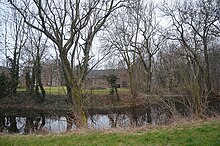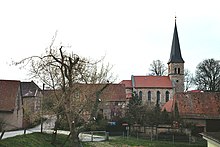Skirts
|
Skirts
City of Lützen
Coordinates: 51 ° 14 ′ 27 ″ N , 12 ° 6 ′ 58 ″ E
|
|
|---|---|
| Height : | 122 m above sea level NN |
| Area : | 11.8 km² |
| Residents : | 599 (Dec. 31, 2007) |
| Population density : | 51 inhabitants / km² |
| Incorporation : | July 1, 2009 |
| Postal code : | 06686 |
| Area code : | 034444 |
|
Location of skirts in Lützen
|
|
Röcken is a district of the city of Lützen in the Burgenland district in Saxony-Anhalt . Until June 30, 2009, Röcken was an independent municipality in which around 600 people lived on 11.8 km². Röcken is part of the internationally known historical and cultural region of Lützen and the surrounding area as well as the birthplace and grave of the philosopher Friedrich Nietzsche .
geography
The town of Röcken is located between Weißenfels and Lützen to the southwest of the city of Leipzig, about 20 kilometers away, in the Leipzig lowland bay and forms a fragment of the original cultural landscape due to the unprecedented interventions in the landscape due to lignite mining . This retained the character of this flat landscape, which is characterized by the arrangement of spacious fields and villages with ponds .
Districts of the former municipality of Röcken were Bothfeld, Michlitz (both previously independent municipalities were incorporated into Röcken on July 1, 1950), Röcken and Schweßwitz (also incorporated into Röcken on July 1, 1950).
The railway line Leipzig-Plagwitz – Pörsten via Röcken has been closed since 1998 (last run on May 23, 1998) and was dismantled after the statutory waiting period in 2005, the embankment is largely used for the asphalted Elster-Saale cycle path.
The B 87 ends approx. 2 km from Röcken at the Lützen junction of the A 38 . About 4 km west of Röcken is the Rippachtal motorway junction , which connects the town with the A 9 in the direction of Munich. In order to drive on the A 9 in the direction of Berlin, we recommend the Bad Dürrenberg junction via the B 87 behind Lützen.
history
The place was first mentioned in a document in 1232. However, it was founded much earlier, presumably by Sorbian settlers. Röcken, surrounded by fertile fields with high-quality loess soil , was a farming village with a manor and small and medium-sized farmers from the start. The village image did not change in the 19th century, when industrialization brought structural and work changes in the surrounding area. Röcken, Bothfeld, Michlitz and Schweßwitz belonged to the Hochstift-Merseburg office of Lützen until 1815 , which had been under Electoral Saxon sovereignty since 1561 and belonged to the secondary school principality of Saxony-Merseburg between 1656/57 and 1738 . The historical traffic route Via Regia from Frankfurt am Main to Leipzig, which runs past Röcken , means that the place is connected to events in Central German history, also because of its proximity to the city of Lützen, which is two kilometers away. On November 15, 1632, the eve of the Battle of Lützen , the King of Sweden, Gustav Adolf , was already in battle order on this road past Röcken towards Lützen, in order to take up position there for the battle that took place the following day. after defeating imperial Croats in Pörsten and Poserna not far from Röcken.
As a result of the resolutions of the Congress of Vienna , Röcken, Bothfeld, Michlitz and Schweßwitz, along with the western part of the Lützen district, became part of Prussia in 1815. They were the 1816 Merseburg in the administrative district of Merseburg of the Province of Saxony allocated. In the course of the first district reform in the GDR, Bothfeld, Michlitz and Schweßwitz were incorporated into Röcken and the place was reclassified to the Weißenfels district on July 1, 1950. With the second district reform in 1952, Röcken came to the Weißenfels district in the Halle district , which in 1990 became the Weißenfels district again and was incorporated into the Burgenland district in 2007.
On July 1, 2009, Röcken was incorporated into Lützen. The last mayor was Marlies Riedel.
The church in skirts
The church in Röcken was built in the first half of the 12th century and has largely been preserved in its original state to this day. With its defense tower, it is one of the oldest church buildings in the region around Lützen. The Romanesque pillars with palmette ornaments inside the church and two epitaphs of the last knights of Kratzsch from the 17th century are worth seeing . Under the early childhood impression of these epitaphs, the adolescent Friedrich Nietzsche stylized the epitaph of the knight in armor on the basis of features similar to the appearance of St. George in his first autobiography From my life from 1858: “(...) in the gloomy sacristy of the church stood at the on one side the superhuman image of St. George, dug in stone by a skilled hand. The noble figure, the terrible weapons and the mysterious semi-darkness always made me look at him with awe. Once, so the legend goes, his eyes were said to have sparkled terribly, so that anyone who would have looked at him would have been filled with horror. ” In this church, Friedrich Nietzsche's parents were married on October 10, 1843, and he himself was married on October 24. Also baptized by his father Carl Ludwig Nietzsche in October 1844 .
The church is registered under the number 094 14183 as an architectural monument in the list of cultural monuments of the city of Lützen .
The church in Bothfeld
The church in Bothfeld was built in 1795 and rebuilt again in 1884. It is a hall church with medieval origins. It is held in the architectural style of the baroque or historicism . The interior is from the 19th century, the organ was taken over from the church in Pobles .
The church is registered under the number 094 14193 as an architectural monument in the list of cultural monuments of the city of Lützen .
Population development
Development of the population (from 1995 reference date December 31) :
| year | Residents |
|---|---|
| 1990 | 665 * |
| 1995 | 618 |
| 2000 | 617 |
| 2005 | 611 |
| 2006 | 610 |
| 2007 | 599 |
* October 3
Personalities
Friedrich Nietzsche and Röcken
The most important inhabitant was the philosopher Friedrich Nietzsche , born on October 15, 1844 in the parsonage of Röcken, who achieved world fame with his works and was buried in his place of birth on August 28, 1900. Friedrich Nietzsche's father Carl Ludwig Nietzsche was pastor of the parish of Röcken from 1842 to 1849. Friedrich Nietzsche's birthplace, built in 1825, is still the parsonage of the parish in Röcken.
- Friedrich Nietzsche memorial in Röcken
The Nietzsche memorial site with a permanent exhibition on the subject of "Friedrich Nietzsche and Röcken" is located in an adjacent building on the church site. The "Friends of Röcken" gradually built it up after 1990 and extensively renovated and expanded it in 2003. Nietzsche's childhood, his relationship to Christianity and the history of his resting place are shown in three rooms . The Evangelical Parish Lützener Land is responsible for the memorial. Birthplace, baptistery, village school and the family grave form a museum ensemble that gives an insight into the world of Friedrich Nietzsche's early childhood years.
The graves of Friedrich Nietzsche and his sister Elisabeth Förster-Nietzsche as well as the parents Carl Ludwig Nietzsche and Franziska Nietzsche, née Oehler and the little brother Ludwig Joseph Nietzsche are in the family crypt at the church in Röcken. With the decision of the Council of the Weissenfels District on December 31, 1986, the Nietzsche family grave was placed under monument protection “because of its historical, artistic and scientific significance for socialist society”, as the reasons given at the time.
In 2000, on the 100th anniversary of Friedrich Nietzsche's death , the group of sculptures “Röckener Bacchanal”, created by the artist Klaus Friedrich Messerschmidt , was inaugurated next to the church in the former cemetery , which shows Friedrich Nietzsche standing at his grave in various situations in his life and is based on a Nietzsche dream . The modeling of the figures corresponds to the real body sizes of Friedrich Nietzsche and his mother Franziska Nietzsche.
Brown coal deposit and mining plans
Due to its coal-bearing subsoil, the town of Röcken is part of the lignite deposit that is located below and around Lützen, and geologically belongs to the Weißelster basin of the Leipzig lowland bay .
The Gustav Adolf opencast mine south of Röcken was opened as early as 1920. Due to problems with the groundwater system, mining had to be stopped as early as 1929. A striking building object from this time is the still existing, but dilapidated gravel washing and coal charging system, which was built not far from Röcken parallel to the railway line. After 1990 the dump of the open pit was reforested with softwood plants.
Comprehensive reduction plans in the form of a large open pit were in the following years, especially during the existence of the GDR no longer realized when skirts were reported also from 1958 to 1966 as "mining reserve" and from 1984 to 1985 exploration drilling at the request of the District Planning Commission of the District Hall in field Lutzen performed which envisaged a later devastation of the community of Röcken within the framework of the energy policy announced by the SED for the "radical exploitation of all lignite deposits" after the year 2000 at the earliest.
At the beginning of February 2006, the Mitteldeutsche Braunkohlengesellschaft announced that it would carry out test drillings to investigate the quality of coal in the communities of Röcken and the neighboring community of Sössen with regard to a possible later development. These test wells began on July 20, 2006 on the territory of the municipality of Sössen , which provoked the protest of the residents. Thereupon, on December 18, 2006, the local council of Röcken announced that it would exhaust all possibilities for the preservation of its localities. In their opinion, the development of the Lützen opencast mine and the associated inclusion and devastation of the towns of Stößwitz, Sössen, Gostau, Kölzen, Röcken, Michlitz, Bothfeld and Schweßwitz as well as parts of the district of the city of Lützen would mean that an internationally known European historical and cultural region would be lost, which Friedrich Nietzsche also had a lasting influence on his development. On February 10, 2007, the citizens' initiatives of Röcken and Sössen, which were active against lignite mining, declared their union and membership of the “Future instead of lignite” campaign in Schneidlingen . At a public hearing that was started in the community of Röcken, a majority of 64% of the residents entitled to vote voted against test drillings on community-owned land. On April 4, 2008, Saxony-Anhalt's Minister of Economic Affairs, Reiner Haseloff, officially announced that the Central German Brown Coal Company Mibrag had shelved its plans to mine coal in the town of Röcken for economic reasons.
Individual evidence
- ^ Karlheinz Blaschke , Uwe Ulrich Jäschke : Kursächsischer Ämteratlas , Leipzig 2009, ISBN 978-3-937386-14-0 , p. 84 f.
- ^ The district of Merseburg in the municipal directory 1900
- ↑ Röcken and its districts on gov.genealogy.net
- ↑ StBA: Area changes from January 2nd to December 31st, 2009
- ↑ Burgenlandkreis - Ev. Bothfeld Church (near Halle / Saale) (page from Architektur Blicklicht; accessed on March 26, 2020)



















